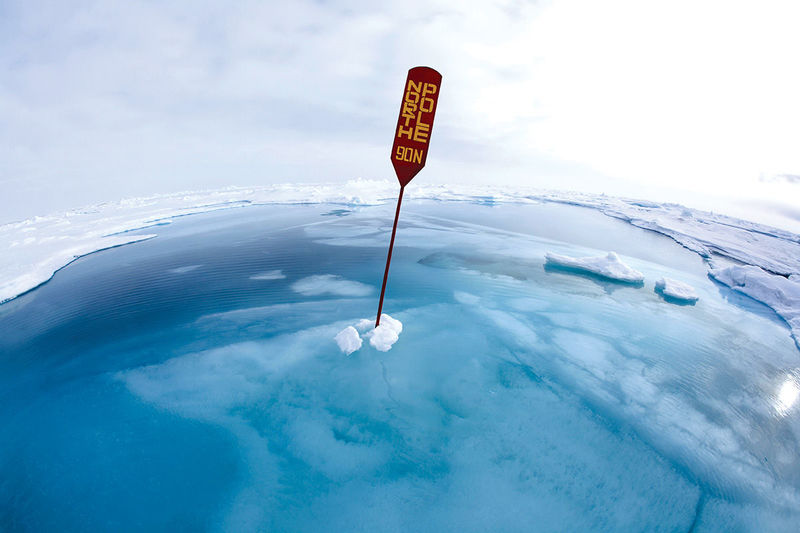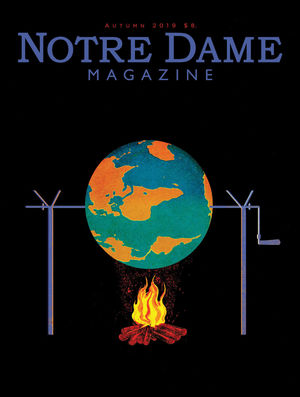 Sue Flood/Alamy Stock Photo
Sue Flood/Alamy Stock Photo
Editor’s Note: A Notre Dame environmental engineer assigned students to read a recent Notre Dame Magazine story about climate change — and the letters to the editor about the article. Below are the students’ contributions to the conversation.
I was at once distressed, emboldened and hopeful after reading the reader reactions to Notre Dame Magazine editor Kerry Temple’s (excellent) article “Before it’s Too Late” in the Autumn issue.
I was distressed by how deeply ingrained some of the fallacies and misconceptions on climate change are — even among well-meaning and highly educated folks — when time is running out to act decisively. These reactions speak volumes on the pressing need for educational programs that familiarize tomorrow’s leaders on the scale, urgency and ethical implications of climate change, and for research that strives toward sustainable and equitable solutions.
On both fronts, Notre Dame is a leader and this emboldens me. Cutting-edge interdisciplinary research at Notre Dame’s Environmental Change Initiative and action-oriented education at the engineering minor, Resiliency and Sustainability of Engineering Systems, are two of many examples of how Notre Dame is addressing this momentous issue.
As a faculty member involved in both programs, I interact on a daily basis with exceptionally bright young minds, who are intent on addressing head-on the defining challenge of their generation. This gives me tremendous hope. Below are reactions from some of these students after being assigned to read Kerry Temple’s article, and the readers’ responses to it, for my undergraduate class Sustainable Development in a Changing World.
Thank you to Notre Dame Magazine for the thoughtful and thought-provoking articles in recent issues — this is great reading material for classes!
Marc F. Muller, PhD
Assistant Professor
Civil and Environmental Engineering and Earth Sciences

Dennis Regan’s letter carries a very condescending tone. His call for Temple to “take a deep breath, relax and embrace the joy of family, friends, community and the abundance that the U.S. of A. has provided you and yours” is hardly relevant to the discussion on climate change. Ignoring the problem at hand will not minimize or diminish it.
The letter does provide various facts and figures. However, some of these numbers are, again, irrelevant to the conversation. The data and trends about the percentage of people living in “absolute poverty” is an interesting one, but it doesn’t connect to the idea of climate change, at least not in a way Regan makes clear. Regan also cites a source mentioning the decline in tornadoes over the past 70 years or so, which is meant to justify his argument that climate change doesn’t have a negative impact on weather patterns. However, according to the Center for Climate and Energy Solutions, there is no known link between climate change and tornado occurrence. Another statistic — that the “world’s tree cover increased by 2.24 million square kilometers” over the past 34 years is accurate according to a report from the University of Maryland. However, these net gains have occurred because, according to Pacific Standard, “warming temperatures . . . are enabling forests to move poleward.” The fact that environments that were previously not suitable for tree growth have warmed to the point where they can support trees shows the destruction environments as a result of climate change. Regan’s final piece of data comes from Wikipedia: although Earth has lost 10.6 trillion tons of ice and snow in the last 50 years, we still have 38,800 trillion tons remaining. Like a good college student, I’ll accept this number as fact. Regan’s intends to point out that the amount of ice and snow that has melted is trivial when you take into account how much is left. However, he doesn’t look at these numbers in a broad enough scope.
According to Ruth Mottram, a climate researcher with the Danish Meteorological Institute, the Greenland ice sheet “sent 197 billion tons of water pouring into the Atlantic Ocean during July” last year. This single event, The Washington Post reported, was enough to raise sea levels worldwide by half a millimeter. This may seem trivial, but this rise comes from one ice sheet over the course of one month — one that included the “greatest single day volume loss from the ice sheet since 1950.” It’s clear that the Earth is warming and ice loss is getting increasingly more severe.
Regan closes his letter much like how he started it, calling for Temple to “cheer up” and ignore the problem at hand. As we are facing the effects of climate change already, it’s clear that this won’t be the solution.
Owen Richey
Freshman, Civil Engineering
In his letter, Robert P. Thacker states that once climate change reformers decide to choose nuclear power as their top solution to reducing carbon-dioxide emissions, then he will be in favor of climate change reform. Thacker is asking others to incorporate his idea while he sits and waits for it to be done. I believe nuclear power is a great solution for climate change, but the only way for reform to happen is for people to add their voices and actions to the movement to motivate government action. Thacker’s lack of effort to advocate for reform is as hypocritical as the environmentalists he criticizes for adding to the carbon dioxide in the atmosphere through the use of cars and electricity.
Jake Franklin
Freshman, Mechanical Engineering
“Before It’s Too Late” presents a heartfelt take on the impact of climate change. I was moved by Temple’s depiction of current issues. He motivated me to make changes. The article prompted many critical letters from alumni. I am writing in response to Daniel Rapp, who points out the undeniable fact that in the past century the global population has increased substantially. Therefore, the resources allocated to satisfy the increased number of people also has grown. Rapp is correct that we could not entirely eradicate the use of fossil fuels and it is true that renewable energy is not yet able to sustain a majority of global energy consumption. However, the benefits make it worth implementing on a small scale and continuing to fund research and development of these technologies. Sadly, this will be a challenge because people who deny the impact of climate change will resist supporting alternative-energy sources. Instead of continuing to use destructive fossil fuels, or eliminating them entirely, we could implement a method to transition to renewables over time.
Margaret Mathews
Freshman, Civil Engineering
In his brief response to climate-change articles, Warren Smith describes a “Venn diagram” criticizing the Notre Dame Magazine editors. He contrasts their reporting on global warming as a crisis with their support for the football team, its fans and its stadium, citing hypocrisy since the travel of the team and fans and the maintenance of stadium infrastructure produce emissions.
I enjoy football. Lots of people enjoy football. And since Mr. Smith graduated from Notre Dame, I’m guessing he enjoys football too. And he is absolutely correct about the emissions all that travel and related activity generate.
I've got an idea — how about we cancel college football games entirely? While we’re at it, we might as well cancel the NFL, NBA, MLB and NHL too, since all those teams and fans create emissions traveling to games (and we definitely should cancel NASCAR — I mean, the entire sport is fundamentally based on creating emissions). Really, all entertainment should cease.
That’s a pretty bleak world that we’ve created together, Mr. Smith, and I don’t think that anyone, including you or the Notre Dame Magazine editors, seriously support such drastic measures in an effort to preserve the planet. We can support football while researching more eco-friendly methods of travel; we can travel to football games while carpooling, and we can enhance and update our stadiums with renewable sources of power.
We have to reevaluate how we produce our entertainment, just as we have to reevaluate our work, schools, factories, businesses, barber shops, grocery stores and every other aspect of our lives. And we have to do it soon — the clock is ticking.
“The best time to plant a tree is 20 years ago. The second best time is now” –Chinese Proverb
Andrew DeLuca
Freshman, Civil Engineering
I am writing in response to Robert P. Thacker’s letter. While I appreciate your call to action and your honest opinions on climate change, I think you are oversimplifying a very complex issue. I agree that we have to stop creating CO2 to solve climate change, but it is impossible to stop burning fossil fuels entirely. As you discussed in your letter, U.S. industrial activity fueled by coal and fossil fuels formed the foundation of our economy today. Such activity is so ingrained in our infrastructure that it would be disastrous to cut it off and jump to an alternative like nuclear power so quickly. Yes, nuclear power is efficient and relatively safe, but it introduces its own set of issues — the most prominent being the disposal and storage of radioactive waste. In other words, every energy alternative introduces a new loop of problems in terms of waste and/or production.
So how do we address this? I think the answer lies not only in reactive approaches like alternative energy sources and carbon sequestration, but also in preventative measures that focus on consumer behavior. Relying on an ability to outsmart problems faster than they can develop is an excuse to avoid significant changes to our lifestyles. If we keep jumping from one form of energy to another with no positive changes in behavior, it’s only a matter of time before we run into another issue as massive as climate change. For example, even though wind and solar energy are renewable, the resources to build windmills and photo cells are not. True climate experts understand these intricacies and the deep hold that fossil fuels have on our society, which is why they are hesitant to dive headfirst into a single alternative like nuclear power.
This is not an excuse to continue burning fossil fuels longer than we have to. Rather, I am trying to point out the importance of policy and economic approaches that address climate change more systemically. That involves approaches that can be frustrating, such as emissions-trading schemes and carbon taxes. However, the realities of political power and economic interests in the U.S., mean that complex, multifaceted approaches are the only way forward.
Matthew Millado
Junior, Environmental Science
Kim McClain mentions how “environmental extremists” over the years have threatened that the earth’s resources are disappearing at an alarming rate but we still “seem to have plenty.” The BP Statistical Review of World Energy in June measured total global oil from proven resources at 188.8 million tons at the end of 2010. This is only enough to oil for the next 46.2 years, should global production remain at the current rate. An article in the The Guardian article states that “we have enough coal to meet 188 years of global production.” Although these predictions reach past our lifetimes, it is important that we change our ways for the benefit of future generations. Environmentalists are not looking for reasons to predict the end of the earth, they are trying to find ways to save what we still have left.
Julia Lee
Freshman, Civil Engineering

Brian Sontchi is correct in stating that we are currently in a period known as the Holocene interglacial, and that the earth goes through warming and cooling periods due to, as he puts it, “the cyclical variability of the sun’s warmth.” However, it is untrue that the warming of the earth is entirely natural and will lead us into a new Ice Age, as Mr. Sontchi suggests. As identified by many climate researchers, including NASA scientists, it is extremely likely (since they cannot make statements with absolute certain, “extremely likely” is the closest any scientist will ever get to saying “definitely”) that the earth’s current warming trend is the result of human activity since the mid-20th century and is rising at an unprecedented rate. Satellite and advanced technological instruments from organizations NASA are not our only source of information; paleoclimate evidence (i.e., ancient evidence found through nature, such as ocean sediment, coral reefs, sedimentary rock, etc.) exposes our current warming trend as occurring roughly 10 times faster than the average rate of the earth’s warming recovery periods that Mr. Sontchi mentions.
While the National Solar Observatory’s data on the linear decline of sunspots is true, that does not mean that we are not at risk of global warming. In the past, warming periods did not involve humans or our effects, so the earth was still in balance; in our current Holocene warming period, however, we have to realize the human impact on the planet is contributing to the crisis. In fact, Mr. Sontchi mentions that the Holocene time period is coming to an end; well, that is not because we are about to enter a “new Ice Age,” as Mr. Sontchi suggests, but rather because scientists are debating whether or not to start the Anthropocene time period early because of humanity’s substantial effect. Time periods are supposed to occur geologically, which is why many think that such a thing is a political move or environmentalist agenda, but there is much cause for a time period shift. Habitat destruction, animal and plant extinction, and environmental degradation in the past decades has been so significant, National Geographic claims, that it would create an obvious partition in the earth’s rock layers. Other options for geological boundaries are marine plankton, which, since humans started burning fossil fuels, have experienced a change in their carbon isotope signature.
Mr. Sontchi explains the devastation the world experienced when the global temperature dropped two degrees Celsius; unfortunately, since the industrial era began, many regions have already warmed up to 1.5 degrees Celsius, with more than a fifth of the world experiencing such an increase in at least one season, if not more. At such a pace, 14 percent of the earth’s population risks enduring heat waves once every five years, as deadly as those of India and Pakistan in 2015. In mid-latitudes, the hottest days would see a 3-degree Celsius increase. That level of warming would not be, as Mr. Sontchi suggests, “good weather to grow food.”
Matthew Purcell
Freshman, Civil Engineering
Ms. McClain noted that raising awareness of environmental issues has had adverse effects on those in poverty. I agree that the United States and other wealthy countries benefitted economically while polluting the planet through industrialization. Withholding the same privilege to developing countries is unfair. However, impoverished countries are going to be the hardest hit from population growth and global warming. According to the United Nations Population Fund and the United Nations Population Division, the populations of the 48 Least Developed Countries (LDC) are growing at almost double the rate of other developing countries. While they represent only 12 percent of the global population, the LDCs will experience 40 percent of population growth in upcoming decades.
I understand your frustration at making changes to help the environment and then being told that more change is necessary and little progress has been made. That would frustrate me as well. Maybe this means we need to shift our approach. Big corporations that burn lots of fossil fuels and spray lots of pesticides can make more powerful changes. I am not denying the power of individual action, but perhaps we should redirect our efforts into supporting companies that are open and honest about their carbon footprint and steps they are pursuing to reduce their pollution.
In our personal lives, there are many ways to help the environment and we all do not have to do the same things. Maybe eating less meat is an easy change for some, while others may prefer to live in a smaller house and use less electricity. The work of preserving our planet will never be “finished.” It takes hard work and determination to achieve anything that is worth having.
Bridget Taylor
Senior, Electrical Engineering
I view climate change through the same lens as John Simone: it is a moral issue. We have acted immorally in our treatment of the earth. His letter attacks capitalism for its selfish shortcomings in acting to harm the environment. Unfortunately, we continue to live in a world where money incentivizes people more than anything; profits blind people and corporations to the direness of the situation.
The letter also criticizes the Catholic Church for not living what it preaches. With its influence across the world, the Church could make the climate future look a little brighter if it made it a priority of promoting lifestyle changes to sustain life on God’s Earth.
Jenna Brancatella
Freshman, Civil Engineering
In Kim McClain’s response to “Before It’s Too Late,” she expresses her view that environmentalists’ responses to global warming are a “hysterical overreaction.”
McClain reports that, despite population growth in recent decades that was supposed to stress natural resources, “we still seem to have plenty.” While this is true for now, we do not have enough to support our current lifestyle for decades to come, which she does not seem to recognize.
As for the danger of carbon dioxide emissions, McClain asks how dangerous the gas could be since humans exhale it. The gas itself is not dangerous to humanity, but dangerous in large quantities to the earth. The greenhouse gas produces an effect that changes the climate. That is why carbon dioxide emissions are dangerous.
Helen Closkey
Freshman, Civil Engineering